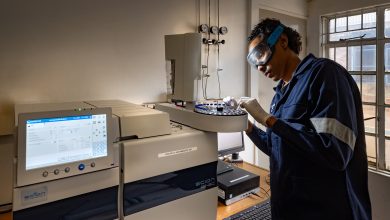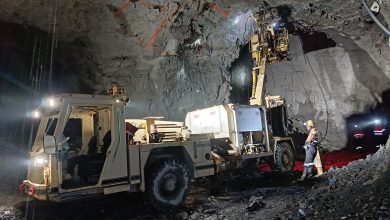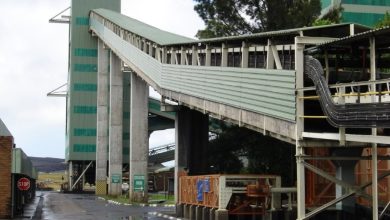
Noddy McGeorge, principal mining engineer at SRK Consulting (South Africa), examines the ideal conditions in which surface miners can be employed and where traditional methods may be more suitable
Surface miners are an adaption of the method of rock cutting that utilises a drum with picks attached to break the rock, similar to the underground continuous miners. There is also a variant that uses a rotating drum that applies the same principles.
Limitations
Given that the machine cuts the rock or ore without blasting one of its limitations is the inherent strength of the material (compressive strength) that it cuts and the mass of the machine and the power that can be applied to the material to be excavated.
Upscaled in size
One of the equipment manufacturers used to apply the equipment in road rehabilitation where the miner cuts the original bitumen surface away. In the last few years, the machines have been upscaled in size to make them suitable for excavating surface mines in both the ore and the overburden material.
Types of surface miners
Below is a picture of a Wirtgen miner loading the cut coal into an adjacent truck on an opencast coal mine in Australia. The second picture is a close up of the cutting drum below the machine with the picks inserted. The third picture is a cutaway drawing showing the cutting action and the discharging of the material.
The key in using this type of surface miner is that the material cut below the drum can either be lifted up and loaded into a truck or simply side casted or left in a windrow behind the machine. The machine is capable of cutting to a depth of between 0.1m to 0.6m in each pass and where necessary can adjust while in motion.
The second type of surface miner is the Vermeer miner where the drum is in the front of the machine and the material is collected behind the drum with a spade with gathering arms. The machine can also operate where it cuts the material and leaves it in place and a secondary operation using a front-end loader and truck removes the material.
Source: N. McGeorge
The cutting method is limited by the picks and is approximately 10 – 50cm per pass which means that the operation can be accurate in cutting only the ore and not the waste hence limiting the dilution. This makes it suitable in thin tabular deposits where drilling and blasting cannot be applied and that the ore has to be selectively extracted.
The drum type surface miner which was developed by Krupp was applied more like a shovel or bucket wheel excavator in thicker seams but could also be used in thinner seams where necessary. Its limitation was the cutting pattern on the drum. Based on the limited cutting profile it only found use in soft applications such as coal and lignite.
Currently the large hydraulic shovels can apply a larger breakout force similar to this surface miner and hence free dig the thicker seams but are not as accurate in separating the ore / waste interface.
Conditions suitable for surface miners
The surface miner is best utilised for selective mining in thin slices to minimise dilution by accurately separating the ore / waste interface. It can be done on inclined seams up to around 20 degrees but becomes traction limited at steeper dip.
The main advantage is that the machine breaks the material without blasting and hence limits dust and other environmental concerns. Also, it allows a better control of any highwall faces and hence allows a steeper wall or better recovery of ore within the mining licence at the boundaries. In thin seams the machine is able to recover material that would be lost using bulk mining methods where the cost and practicality of recovering the ore becomes prohibitive.
Typically, in most current opencast operations the cut off on seam thickness with large bulk mining is at 0.75m based on the physical digging parameters and often more when the cost of extraction is considered. Based on the productivity of the machine, which is governed by the depth of the cut and the
This can be a constraint when the full mining process includes other mining equipment that may constrain the available area and where the surface miner activities are not matched to the speed of exposure of the ore. The cutting process also generates a small well graded sized product and hence eliminates secondary sizing at the plant. In cases where the ore is cleated or closely jointed the system can handle the excavation with limited complications.
When the seam is thin the alternatives to drill and blast include ripping with a dozer or trying to free dig with an oversized shovel but these methods lose the degree of selectivity that the surface miner can apply. The increased dilution then makes the methods cost prohibitive. In some applications the surface miner may also compete in a capital shoot out with the bulk mining method by eliminating the drills and loader providing the overall ore targets are within the capability of the machine.
Rock conditions determining the type of equipment
Like any rock cutting application the force that can be applied at the point of the pick and the speed of advance all are interrelated as well as the control of the depth of the cut which result in the productivity of the system. The typical range of compressive strength of material that the miner can cut is between 10 and 70 Mpa with the consequent alteration of the productivity. In the softer materials the material dispatch method can also affect productivity where material does not flow adequately or time is lost changing between trucks.
The table below shows the types of material that can be mined currently based on their compressive strength.
The production rates of the larger machines can range from an instantaneous rate of 1500 Bank cubic meters per hour (BCM’s/Hr) in the soft material to around 500 BCM’s/Hr in 50Mpa material. This can be contrasted to a typical underground continuous miner that cuts at a rate of approximately 500 BCM’s/Hr in coal at an instantaneous rate. The advantage in the surface miner is there is less time lost in the dispatch of the material to the clearance mechanism. This means on coal a typical large miner should be capable of cutting between three to four million tons per annum in a coal application. The surface miners have been applied in Iron ore, limestone, coal, lignite, kimberlite, salt and phosphate application and Wirtgen report having sold over 450 machines into mining applications.
Steps to optimise the performance of surface miners
The main application of the miner is to produce ore where the conditions do not allow bulk scale methods with drilling and blasting, where it reduces cost per unit. Hence the main optimisation is to keep maximum productivity of the machine and its cutting time maximised to keep the costs down to compete with the bulk mining methods.
Surface loading equipment typically achieves around an 80% availability and around 80% utilisation in a well designed operation. It is expected that the availability targets can be matched by a surface miner but the utilisation would be lower because of the more frequent changing of the picks on the drum and the repositioning of the equipment.
As noted the area needed for the surface miner operation is larger than the bulk mining so the inventory of available cutting area needs to be large to get the best utilisation. In some operations the multiplicity of seams and their constrained shape in casting methods make this difficult. Where the machine is being used for a specific application in optimising resource recovery etc the optimisation is mostly around maximising cutting time on the machine.
Benefits that surface miners bring to open-cast mining projects
As noted, the surface miners can have some specific advantages in the extraction of the ore and can produce at a reasonable rate if the overall mine production rate is small. This then gives a capital advantage over the bulk mining method for the smaller capacity. A single surface miner will replace the drills as well as the loader in a bulk operation. The maintenance of a single unit as opposed to multiple units may also be an advantage.
Depending upon the project location, the servicing of the machine by the equipment manufacturer may be a constraint. When mining close to the reserve boundaries, the use of the surface miner allows a steeper slope to be cut thereby maximising resource extraction in the property.
The other benefit is because of the accuracy of the cutting of the waste / ore interface and minimising dilution it allows recovery of thinner seams that are normally discarded. The operating cost of the equipment is unlikely to compete with the bulk mining method in seams that are 1.5m or thicker so its key benefit is in recovering the thin seams. The grading of the material may have a benefit in the elimination of secondary breaking which also attracts losses and plant beneficiation inefficiencies.






